Red and Green for Winter
/0 Comments/in Flowers, Houseplants/by Lee ReichA Mexican Native Adapts to Pot
A recent snowfall draped the landscape in magic. The white blanket settled softly on every horizontal surface to create a harmony in white.
Still, I miss green. Even better than seeing some green plants would be to liven up that green with, from the opposite side of the color wheel, red. And even better still would be to have this red-and-greenery close at hand — indoors.
Three plants fill this bill well, and are easy-care houseplants.
The most obvious and common member of this clan is poinsettia.  Breeding, manipulation of their greenhouse environment, and plant growth regulators have transformed this sporadically blooming native of Mexico into a compact plant bursting into large blossoms for Christmas in foil wrapped pots.
Breeding, manipulation of their greenhouse environment, and plant growth regulators have transformed this sporadically blooming native of Mexico into a compact plant bursting into large blossoms for Christmas in foil wrapped pots.
(Actually, the “blossoms” are not blossoms, but colored bracts, which are modified leaves. Peer into the whorl of bracts and you’ll see small, round, yellow cups, called cyanthiums in which inconspicuously reside the true blossoms.)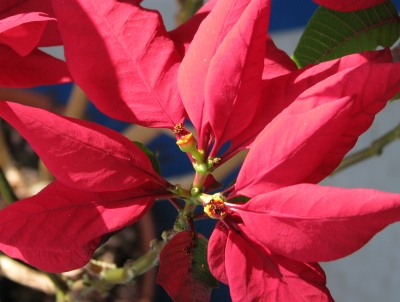
Poinsettia need not be a throwaway plant when the holiday season ends. The plant is easy to grow and, with just slightly more trouble, can be brought into bloom again this time next year. The plant is photoperiodic, meaning it blossoms after a period of exposure to short days. For poinsettia, that’s about a month of 12 hour, or less, days. That photoperiod begins about mid-September around here, so the plants could be left outdoors for the period as long as they’re not exposed to freezing temperatures. Or a plant could be moved in and out of a closet.
Although the photoperiod is spoken of in terms of length of day, length of darkness is what really matters. So each day’s dark period must be uninterrupted; no car headlights, table lamps, or even a flashlight.
If all this seems like too much trouble, just treat a poinsettia like any other houseplant. Photoperiod doesn’t stand alone in prompting flowers. Given good growing conditions, a poinsettia will still blossom — just not at Christmas.
Worth Having Even If It Does Come Late, or Early
Christmas cactus also offers red-and-greenery in winter, and is also photoperiodic. But not always. In a cool room, below 60°F., the plant will flower no matter how long each day’s light stretches. Even if it’s exposed, artificially of course, to continuous light!
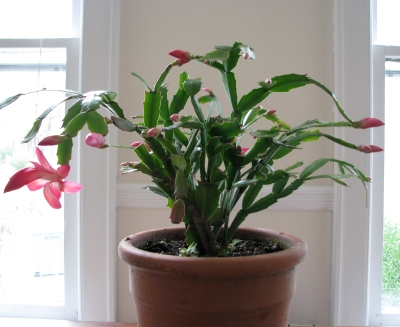 Above 60°F, temperature steps in to play a role. At room temperatures, or thereabouts, a Christmas cactus needs about the same day length as does poinsettia, except that it might not need the weeks and weeks of short days before it decides to bloom. Then again, it might wait a few weeks, to throw in another wrinkle, depending on the variety of Christmas cactus.
Above 60°F, temperature steps in to play a role. At room temperatures, or thereabouts, a Christmas cactus needs about the same day length as does poinsettia, except that it might not need the weeks and weeks of short days before it decides to bloom. Then again, it might wait a few weeks, to throw in another wrinkle, depending on the variety of Christmas cactus.
My tack has been to give my plant reasonably good growing conditions, with bright light in winter and a little shade in summer and a well-drained potting mix rich in peat or other organic material, and let it blossom according to its whim. In which case “holiday cactus” might be a better name for these plants than “Christmas cactus” because blossoms might unfold during Thanksgiving, Christmas, Easter, or anytime in between.
“Butterflies” in Winter
The last plant of this triad is my favorite: cyclamen. In bloom, it looks like delicate, red (or pink or white) butterflies fluttering above the mottled green, heart-shaped leaves.
Cyclamen’s native habitat — the Mediterranean, with its cool, wet winters and hot, dry summers — offers hints of the plant’s ongoing care and flowering needs.  This time of year, late fall going into winter, is when the plant is flowering and wants to be kept cool (preferably no higher than about 65°F.), moist (but not waterlogged), and in indirect light (which casts no more than a fuzzy shadow). Under these conditions, those butterflies can hover over the plant for weeks and weeks.
This time of year, late fall going into winter, is when the plant is flowering and wants to be kept cool (preferably no higher than about 65°F.), moist (but not waterlogged), and in indirect light (which casts no more than a fuzzy shadow). Under these conditions, those butterflies can hover over the plant for weeks and weeks.
As spring comes — that is, “spring” indoors — leaves start to yellow and flowers fade. The plant is going dormant. At this point, the plant needs less water, the amount commensurate with the vibrancy of its leaves. Come fall, leafstalks start to appear again atop the bulb (botanically a corm, which is a short, swollen underground plant stem that is a storage organ), and the cycle begins again.
My favorite cyclamen species is Cyclamen hederifolium (ivy-leaved cyclamen).
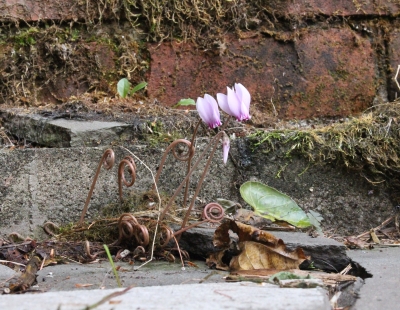
Cyclamen flower in a crannied wall
It’s a very much scaled down version of the potted cyclamen you see for sale this time of year. It’s cute. Besides that, it’s also cold-hardy outdoors here. Some self-seeded “volunteers” even have established themselves to brighten up cracks between the flagstones of my terrace, blossoming each year in early fall.
End of Year Punch List
/6 Comments/in Fruit, Pests, Planning, Tools/by Lee Reich
Winterizing
My carpenter friends, near the end of their projects, have their “punch lists” to serve as reminders what odds and ends still need to be done. I similarly have a punch list for my gardens, a punch list that marks the end of the growing season, a list of what (I hope) will get done before I drop the first seeds in the ground next spring.
(No need for an entry on the punch list to have the ground ready for that seed. Beds have been mulched with compost and are ready for planting.)
Hardy, potted plants, including some roses, pear trees, and Nanking cherries, can’t have their roots exposed to the full brunt of winter cold. I’ve huddled all these pots together against the north wall of my house but soon have to mound leaves or wood chips up to their rims to provide further cold protection.
I’ve huddled all these pots together against the north wall of my house but soon have to mound leaves or wood chips up to their rims to provide further cold protection.
I’ll save some leaves to protect strawberry plants. Their insulating blanket won’t go down until weather turns colder, with the soil frozen an inch deep, or else their evergreen leaves will rot beneath the leaves.
I’ll be digging out or cutting down a number of woody plants, some even 10 or 20 years old, in the next few days or weeks to make way for better ones. (Ruthless!) Anna hardy kiwifruit, short for Annanasnaya, grows very well but ripens a bit late and doesn’t have quite as good flavor as my other varieties: Geneva, MSU, and Dumbarton. So out it goes. The same goes for Mars, Concord, and Cayuga White grapes; their flavor isn’t up to snuff. And Halle’s Giant, Lewis, and Clark filberts, except that their shortcoming is their susceptibility to the disease filbert blight.
A 5 gallon bucket filled with equal parts sifted compost and soil will be ingredients for any potting soils I’ll need for seedlings from midwinter on. For the finished potting soil, I’ll mix in another 5 gallon bucket with equal parts peat moss and perlite.
One sunny day soon I’ll lean pitchforks, rakes, and shovels against the garden carts and brush them with linseed oil diluted with equal parts paint thinner.  After the handles have been wiped down, 10 minutes later, they’ll be in good condition for at least another year.
After the handles have been wiped down, 10 minutes later, they’ll be in good condition for at least another year.
Pruning hardly needs to be added to my punch list. I’m reminded about this annual job every time I look out the window or walk out the back door.
Deer at Bay
Protecting some of my trees and shrubs from animals doesn’t make it to the punch list either — because it needs to be done by now! Young pears (Concorde, Abbe Fetal, and Lady Petre) and apples (Liberty, Macon, Hudson’s Golden Gem, Ashmeads Kernel, and Pitmaston Pineapple) already have their hardware cloth and/or plastic collars protecting their bottom couple of feet of growth.
What about branches higher up, the ones the deer would find tasty. Thanks to fencing at both the north and south ends of my property, a couple of Deerchaser battery-powered repellants, two outdoor dogs, and vibes from me, deer rarely venture on site. But, as I discovered this past summer, just one deer on just one night can do a lot of damage to a young tree.
So this year I’m putting 5 foot high by 3 foot diameter cages of 2×4 welded wire fencing around my young apple trees. 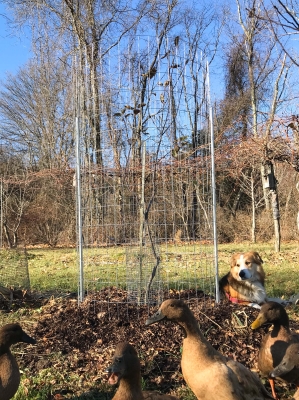 The pear trees, close to the house, don’t get bothered. The problem with such cages is that it’s a hassle to weed or prune within the cage — both very important for young trees. Two metal stakes, each a 5 feet length of EMT electrical conduit, woven into part of fencing on opposite sides allows me to slide the fence up and down to get inside a cage to work. These trees, which are replacing my very dwarf apple trees, are semi-dwarfs which can fend for themselves once they get above 5 feet. Then I’ll remove the cages.
The pear trees, close to the house, don’t get bothered. The problem with such cages is that it’s a hassle to weed or prune within the cage — both very important for young trees. Two metal stakes, each a 5 feet length of EMT electrical conduit, woven into part of fencing on opposite sides allows me to slide the fence up and down to get inside a cage to work. These trees, which are replacing my very dwarf apple trees, are semi-dwarfs which can fend for themselves once they get above 5 feet. Then I’ll remove the cages.
Memorables, for Vegetables
And now, some notes for next season’s vegetable garden . . .
Reduce the number of pepper varieties to those that perform and taste best here: Sweet Italia,
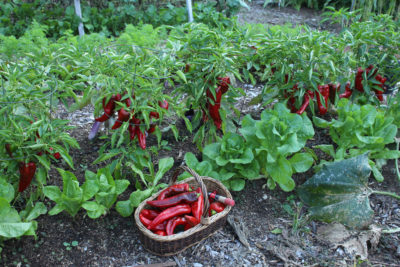
Italian Sweet peppers
Carmen, and Escamillo. And stake them right from the get go.
Plant a greater proportion of tight-necked onions, such as Patterson, New York Early, and Copra, to avoid bacterial diseases.
Plant less bok choy; no need to be inundated by them just because the space is available.
Keep an eye out for whiteflies and caterpillars on cabbage family plants; act sooner rather than later to keep them in check.
Plant more Shirofumi edemame; 30 feet of bed should be about right, they need a long, hot season.
Try King of the Garden Limas again, but plant even earlier indoors.
Get Out!
Okay, time to get outside to work on my punch list before any snowfall limits the possibilities.
Autumn’s Leaves
/2 Comments/in Design, Planning/by Lee ReichWherefrom the Colors?
Autumn is a season when New York’s Hudson Valley, and much of the Northeast, unfolds in all its glory. Not this autumn, though. What’s going on in the leaves this year? Is there anything I can do about it?.
Chlorophyll is what makes leaves green, but hidden behind that green, all season long, are some of autumn’s colors. Chlorophyll must be continually synthesized for a leaf to stay green. The shorter days and lowering sun of waning summer are what trigger leaves to stop producing chlorophyll and let some of the other colors come to the fore.
Yellows and oranges, no longer masked by chlorophyll green, come from carotenoids, which help chlorophyll do its job of harvesting sunlight to convert into plant energy. Thank carotenoids for the warm, yellow glow they give to gingko, aspen, hickory, and birch leaves.
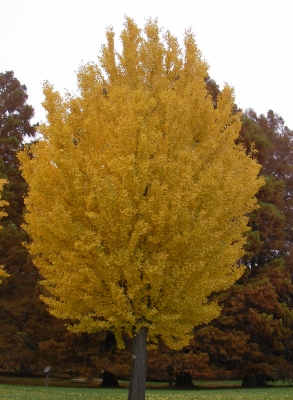
Gingko
Tannins are another pigment, actually metabolic wastes, that all summer are hidden by chlorophyll. Their contribution to the fall palette are the season’s subdued browns, notable in some oaks and enriching the yellow of beeches.
Because leaves harbor carotenoids and tannins all summer long, nothing particular about autumn weather should either intensify or subdue their autumn showing. I’m blaming this autumn’s poor show on the season’s extended warm weather. It was slow to arrest chlorophyll production and induce leaf drop. A couple of hard freezes brought the whole works to a screeching halt, so instead of showy yellow leaves, my witchhazel’s stems are now “adorned” with wrinkled, green leaves frozen in place. Other trees and shrubs suffered a similar fate, and their frozen, green leaves are dropping without any fanfare.
Autumn color also spills out reds and purples, most evident in red maples and some sugar maples, scarlet oak, sourwood, blueberry, and winged euonymus. Those reds and purples come from anthocyanins, yet another pigment. Except for trees like Purple Fountain beech and Royal Purple smokebush, whose leaves unfold dusky red right from the get go in spring and remain so all season long, in most leaves anthocyanins do not begin to develop until autumn.

Sugar maple
Anthocyanin formation requires sugars, which accumulate best with a combination of warm, sunny days to maximize photosynthesis, and cool, but not frigid, nights to minimize nighttime burning up of accumulated sugars. A cloudy, rainy autumn means less red because less anthocyanin is formed, and any that does form is diluted. Warm nights, such as characterized much of autumn, reduce anthocyanins by burning up much of each day’s sugar production. The result: Less reds and purples, as evidenced by the blah color of this year’s blueberries in my garden and maples in the forests.
Can We Make the Color Better?
Is there anything we can do about the autumn show?
Here in the garden, my role in the autumn show is to plant trees genetically programmed for good autumn color. Colorful trees and shrubs include goldenrain tree, hickory, ironwood, and black tupelo. Certain varieties within each species might pack a bigger wow than the others. Hence the spicebush variety Rubra, brick red in fall, or Wright Brothers sugar maple, whose leaves become a mottling of gold, pink, orange, and scarlet. Other especially colorful varieties include Autumn Flame and October Glory red maple, Commemoration and Legacy sugar maple, Autumn Gold and President gingko, and September Beauty Chinese sumac.
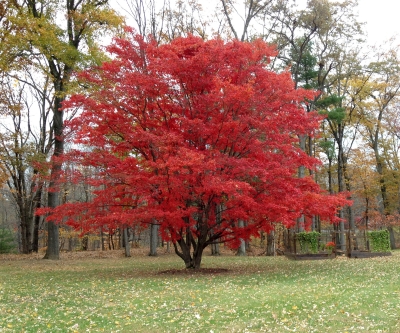
Japanese maple
Despite this autumn’s weather, fothergilla and Japanese stewartia both managed to look as flamboyant this year as in others. If you believe that, going forward, autumn weather is going to bring on less spectacular color, choose varieties that originated from more southerly latitudes.

Fothergilla

Stewartia
And if warmer autumns are going to be one effect of global warming, we can help the autumn show beyond our gardens, in the forests, by traveling less or more efficiently, using less plastic and other petrochemicals, eating more locally grown food and less farmed meat, investing in energy-efficient appliances and renewable energy, etc. (For more, see https://www.conserve-energy-future.com/stopglobalwarming.php.)
Back in the garden, my other role in ratcheting up the reds and purples is to make sure that leaves bask in light. I plant a tree where light is adequate (for that species) and, as necessary, prune so that branches don’t shade each other. Street lights don’t count as light, and actually have a negative effect, disrupting the signal that days are getting shorter and it’s time to slow chlorophyll production.
Lee’s New Book!!
Knowing something about how plants work can make gardening more interesting as well as make the landscape prettier and vegetable gardens more productive. And that’s the thrust of my upcoming book, The Ever Curious Gardener: Using a Little Natural Science for a Much Better Garden, to be published in early spring of 2018 but available for pre-order through Amazon or, signed, from me.

